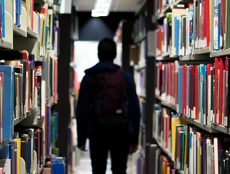
Articles
Editor’s Picks
5 EdTech Initiatives Delivering Learning Resources to Migrants and Displaced People Around the World: UNESCO
By Henry Kronk
November 24, 2018
There are currently more refugees, migrants, and displaced people than the world has seen since the fallout of World War II. Migrants face uncountable challenges. Securing proper education—especially for young people—would be somewhere near the top of the list. The United Nations Educational Scientific and Cultural Organization (UNESCO) proposes an incredibly ambitious response: “Leave no one behind.” Those words begin their latest Global Education Monitoring Report 2019.
As the authors state in their Executive Summary, “Migration and displacement interact with education in many ways.” In some countries, like Canada, migrants are encouraged to attend public school alongside their non-migrant peers. Elsewhere, migrants are educated separately from learners who were born there. Many cases lie somewhere in between.
The UNESCO Global Education Monitoring Report
There’s no question, however, that migration affects the education systems of all countries. The authors distinguish between voluntary migration and coerced displacement, writing, “International migration mainly affects high income countries, where immigrants make up at least 15% of the student population in half of schools. It also affects sending countries: More than one in four witness at least one-fifth of their skilled nationals emigrating. Displacement mainly affects low income countries, which host 10% of the global population but 20% of the global refugee population, often in their most educationally deprived areas. More than half of those forcibly displaced are under age 18.”
To answer this growing issue, the UNESCO authors lay out numerous suggested policy focus areas. Policy Focus 15 describes how “Technology can support education for displaced people.”
Edtech and eLearning, according to the UNESCO authors, offer a huge potential to supplement migrant education, but numerous obstacles also stand in the way. Roughly 95% of displaced people live in areas that offer at least 2G mobile data coverage, while over 60% have access to 3G. Despite this coverage, only 40% of migrants have access to a smart phone.
The UNESCO report identifies numerous ongoing efforts that seek to provide education via technology to displaced people around the world.
1. The Network Schools Programme
In 2017, the UN High Commissioner for Refugees (UNHCR) partnered with Vodafone to deliver both internet and electric power to 20 primary and secondary schools in the Democratic Republic of the Congo, South Sudan, the United Republic of Tanzania, and Kenya. Internet is delivered via satellite or mobile connections while the initiative supplies power through solar powered batteries and a backup generator. The initiative hopes to reach 60,000 learners by the end of 2018.
2. World Possible’s Remote Area Community Hotspot for Education and Learning (RACHEL)
Developed by the NGO World Possible, RACHEL is a portable data-light server that provides access to resources like Wikipedia and Khan Academy. Learners can access and download these materials through the device.
While these interventions are great in terms of ICT solutions, they often struggle to address other issues, like aligning the resources they provide with the curricula being taught.
The report, however, also identifies a few initiatives that seek to do both.
3. Tabshoura (‘Chalk’)
An effort of the NGO Lebanese Alternative Learning, Tabshoura offers eLearning options for pre-school in French, English, and Arabic. It is delivered by the open LMS Moodle.
4. Nafham (‘We Understand’)
Nafham acts as both an eLearning resource and a user generated platform. The group has created numerous educational videos on their own, but also encourages teachers to upload their own content. Roughly two-thirds of their 10,000+ videos are user created and, collectively, the library covers about 75% of Egyptian national curriculum and about 35% of the Syrian national curriculum.
5. Teacher Support via Connect to Learn
The UNESCO authors also highlight how useful digital technology can be for teachers who need to be able to reach out to learners outside of the classroom and form their own online communities. In the Domiz refugee camp schools in Dohuk, Iraq, a collaboration between Ericsson, the IRC, AsiaCall, and the U.S. Bureau of Population, Refugees, and Migration, put technology and an internet connection in the hands of 160 Syrian refugee teachers.
As the authors write, “The objective was to prepare teachers to implement Healing Classrooms, which focuses on providing psychosocial support to children affected by conflict through a compassionate classroom environment and instructional videos. The professional development programme focused on transforming technology tools into education resources (GIZ, 2016).”
The UNESCO authors conclude the subsection on technology policy by highlighting two main challenges that remain in deploying technology to aid the education of migrant and displaced people.
“Two issues raise the main questions. A striking feature is that most initiatives provide content prepared forvery different learning contexts than those in which refugees generally find themselves. Despite attempts to adapt content, compatibility with host national education systems is the exception. This poses a risk for international organizations that support such initiatives and also adopt the principle of inclusion of refugees in national education systems, as they have a responsibility to work with governments, which are absent from such interventions. It is important to recognize that technology cannot replace participation in formal schooling and that most technology-based interventions can work as complementary or interim solutions. Second, many initiatives involve private-sector technology firms. Their motivation combines philanthropy and profit considerations, the latter ranging from brand image and innovation testing to, in some cases, entry into new markets. International organizations, which sometimes support such partnerships with few strings attached, are responsible for ensuring that they are well coordinated and serve the ultimate aim of including refugees in national education systems.”
Read the full report here.
Featured Image: Radek Homola, Unsplash.









No Comments